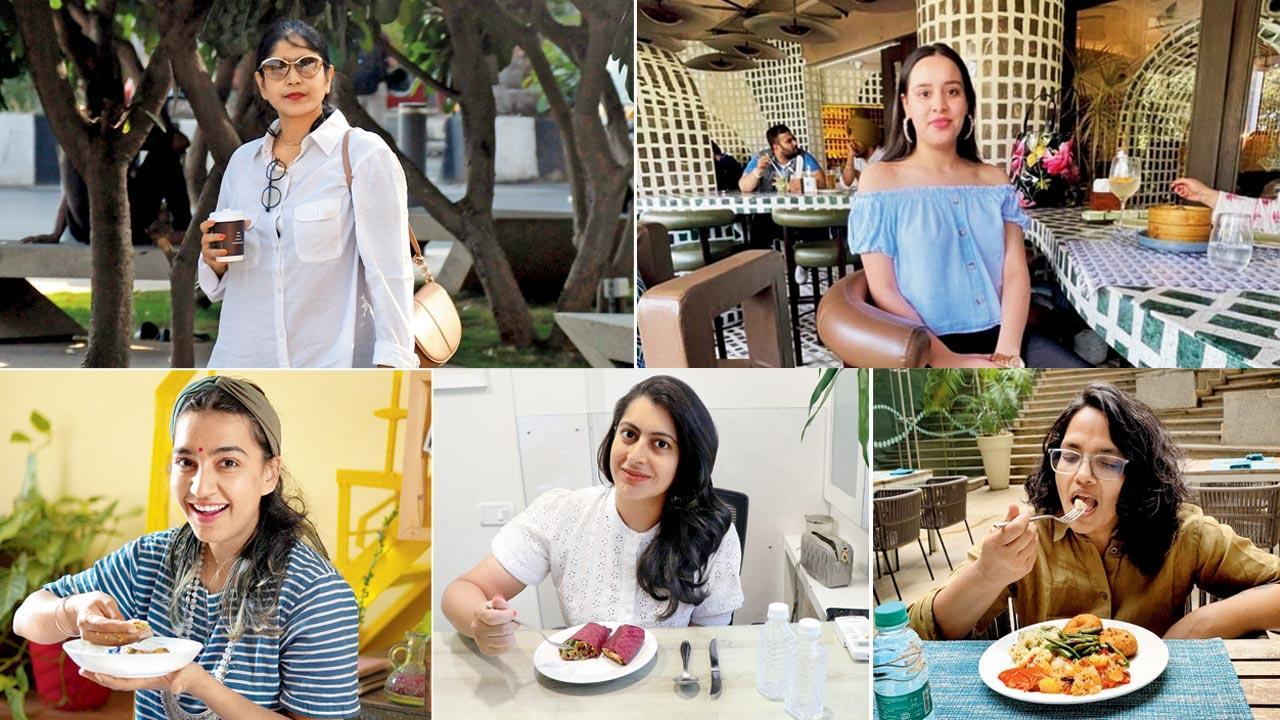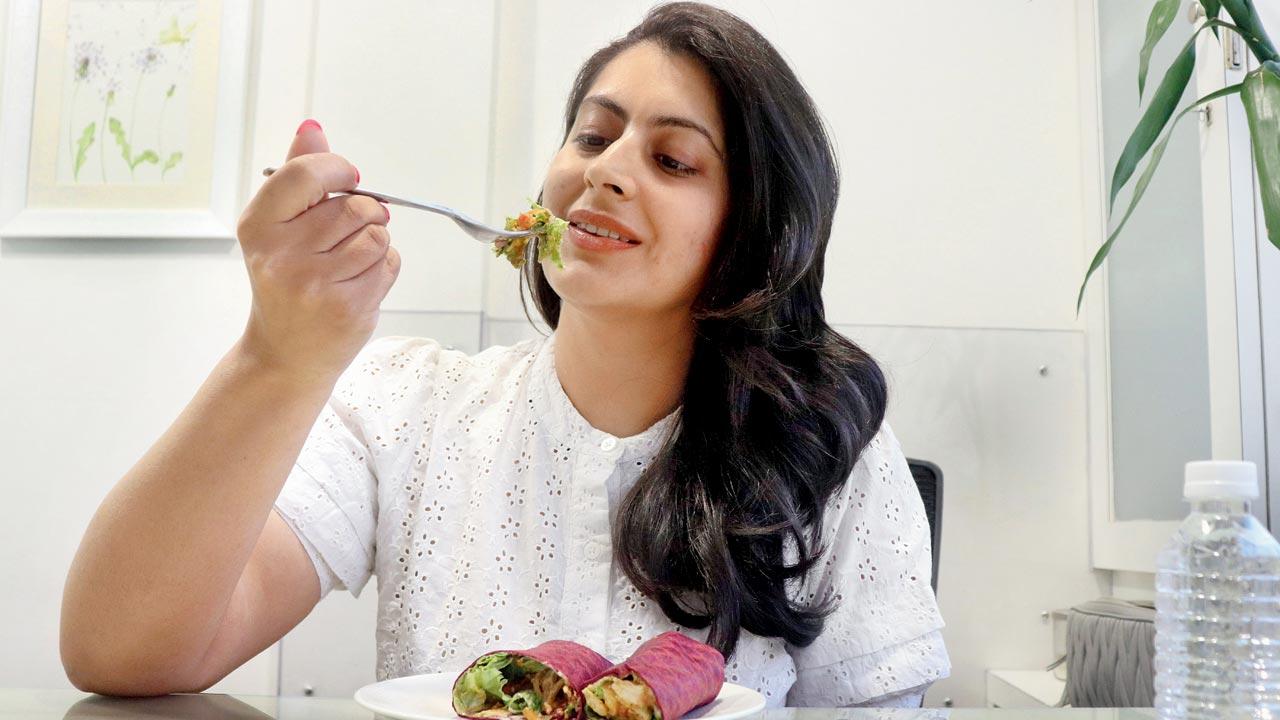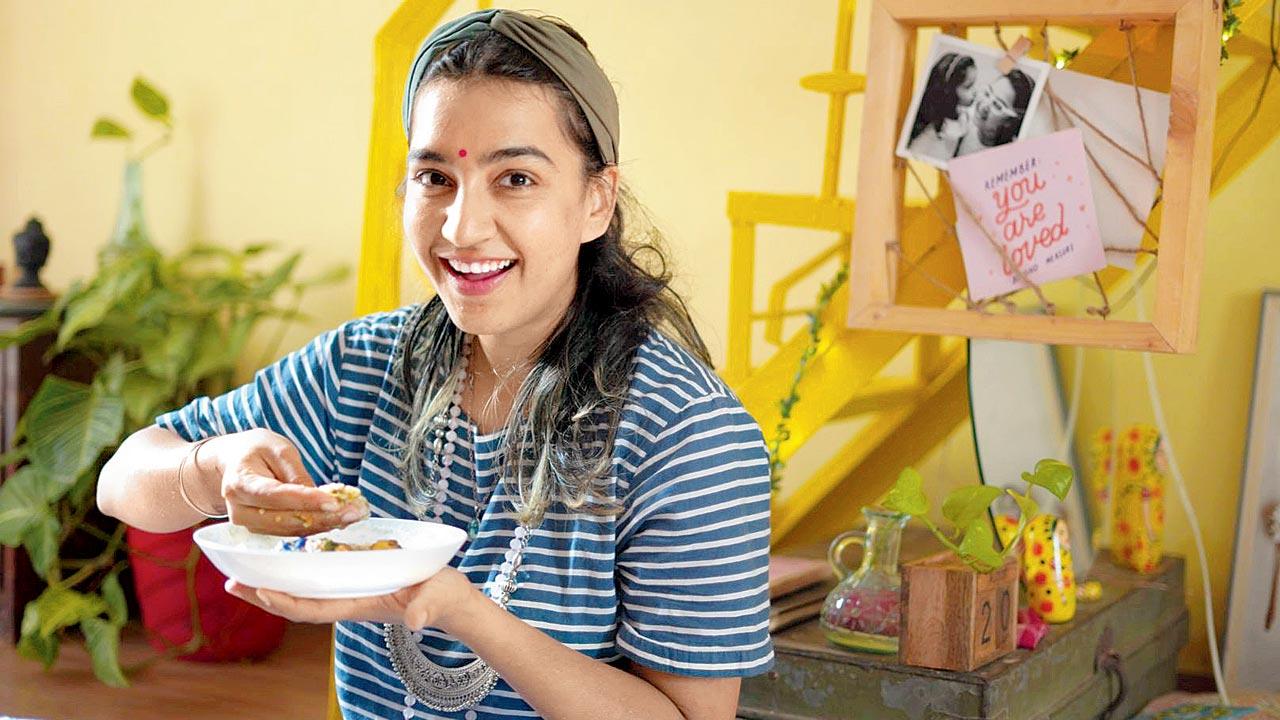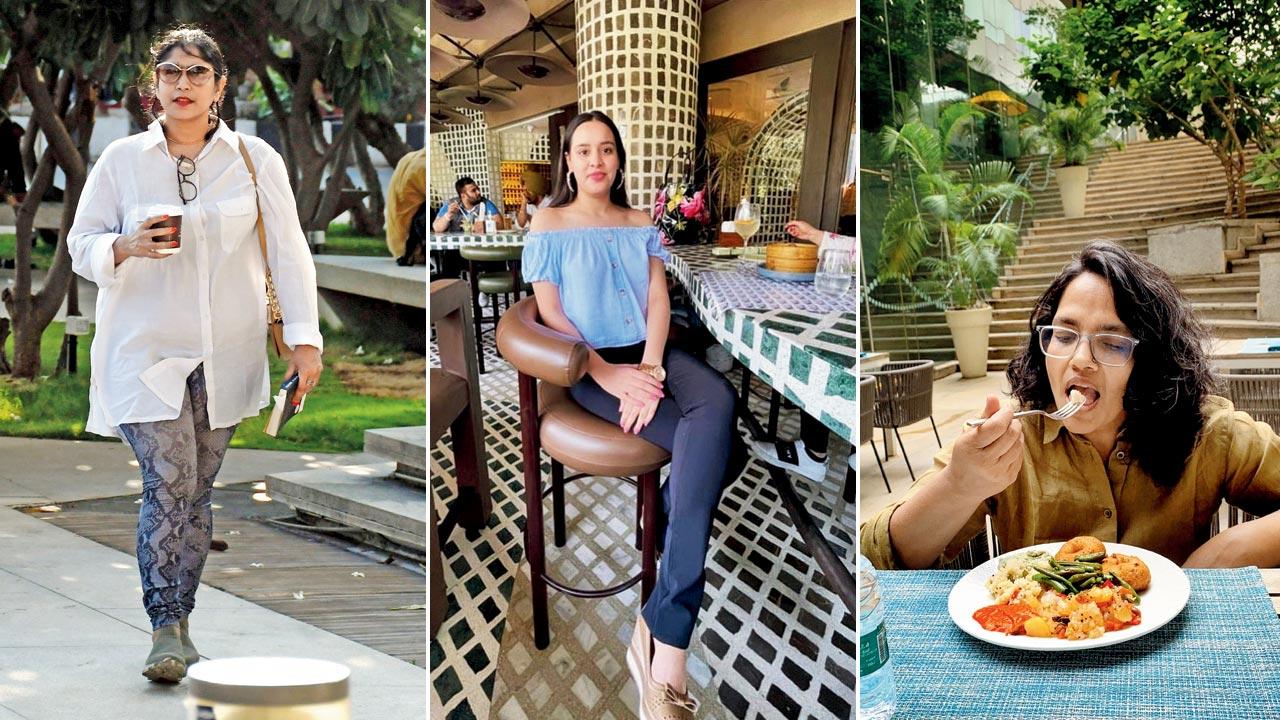Pushed by health complications, inspired by yogic practices or desire for restraint, OMAD practitioners are eating just one meal a day. But, how! Bade aaram se

Mukta Raut, Ishmeet Kaur Sethi, Amrita Kaur Rana, Arti Shroff and Arathi Sen
It's noon, and Arathi Sen sits down at the dining table for brunch. It’s dal with a carefully considered ghee tadka, rice, sabzi and fish or chicken; the masalas are ground in a traditional stone sil-batta. She might have a gulab jamun later, if she feels like it. She eats slowly, mindfully.
This is pivotal. It’s her only meal.
She’s been up since 5.30 am, has done two-and-a-half hours of the Vinyasa flow. Her family of four male humans, and two female dogs is fed and walked. The rest of the day, till 11.30 pm, will be occupied by running her advertising business, taking on some dog training clients, keeping her four-month-old puppy Xena good, and sundry family stuff. “I can’t eat a hurried meal,” says the 50-year-old, “I have to sit down and enjoy it. On the days I eat mindlessly, I can sense a downfall in my emotions; I feel dense.”
 Pic/iStock
Pic/iStock
This has been Sen’s routine for nearly eight years. Even through debilitating PCOS (Polycystic Ovary Syndrome) and fibroids that left her bleeding for 25 days a month; with the onset of menopause, she has bled thrice this month. She may have some fruits and nuts in the evening; but she does not need to lie down. Nor does she take it slow.
That one meal a day (OMAD) sustains her high-energy life, as it does that of most practitioners we spoke to. It’s an extreme form of intermittent fasting (IF), which has helped devotees shave kilos, manage blood sugar and pressure, as well as exorcise cravings. Instead of eating in an eight-hour window and fasting for the rest of the day, OMAD practitioners have one meal a day and supplement it, if they feel like it, with tea, coffee, a smoothie, fruits or nuts. And there are no restrictions on what to eat for that one meal—it could be soul-satisfying dahi-chawal-papad plate or a dozen vada paos.
 Fresh from a 10-day naturopathy retreat, Arti Shroff is determined to continue the soothing routine of starting her day by connecting with nature and eating only lunch. Pic/Anurag Ahire
Fresh from a 10-day naturopathy retreat, Arti Shroff is determined to continue the soothing routine of starting her day by connecting with nature and eating only lunch. Pic/Anurag Ahire
Unlike fad diets, most adopters of this practice that mid-day spoke to arrived at the decision via a spiritual or yogic route. It was a desire to nourish the body and not overload it, exorcise the hold of starch and sugar-rich junk food; to free up brain cells for graver tasks, such as meditation or deep focus, and to stop diverting precious energy to never-ending digestion.
“I used Swiggy like it was a video game, ordering Chinese, ice cream, pizza, dessert,” says Arti Shroff, a psychologist who practises in Kemps Corner. “Food was a stressbuster; I did not plan my meals.” It changed when she went to a naturopathy retreat for 10 days to take hold of her poor food choices. There, her day would start with a glass of lemon-and-ginger water; a simple lunch of roti-sabzi-dal was the most important meal of the day, followed by coconut water at 2 pm and fruit juice at 6 pm. “Dinner was like lunch, so I started skipping it because it didn’t feel appetising,” says the Breach Candy resident, “When I returned to the city, I expected to go on a mad binge, but I didn’t feel like eating junk food. So I decided to follow the same routine.”
 Amrita Kaur Rana, wellness digital content creator
Amrita Kaur Rana, wellness digital content creator
And it has stuck. For the past week, she started her day with a glass of lemon-ginger-water by the window at 5.30 am. Lunch is a bowl of poha, or three theplas and dahi, or dahi-paratha/chilla. She has coconut water or a smoothie in the evening, if she feels hungry; and might add a bowl of hot soup for dinner as the weather changes to the monsoons. “I have realised the difference between craving and desire,” says the 36-year-old, “Craving has an emotional compulsion to it.” To keep a firm grip on it, Shroff maintains a connection with nature. She spends time mindfully, which keeps stress under control.
Mukta Raut first went OMAD six years ago, specifically to better her concentration as she embarked on freelance life. “I was juggling many projects that needed my concentration,” says the instructional designer. “I had tried intermittent fasting and it had helped me focus better, and cut cravings, plus I like the concept of eating less.” She eats once a day during Navratri and likes how she feels. “It frees up so much mind space from not having to plan a menu,” says the Bandra West resident, “I enjoy how much it helps meditation.”
 Mukta Raut tried OMAD six years ago, and is keen on going back to it as soon as she builds an emotional resilience through prolonged meditation so that she doesn’t depend on food for support. Pic/Ashish Raje; Ishmeet Kaur Sethi found that eating whatever she liked, as long as it was once a day, did not affect her metabolism. Now, depending on her mood, it can be a dosa or a burger; For almost seven years, Arathi Sen has been eating a fulfilling, mindful brunch in peace, without denying herself anything she wants
Mukta Raut tried OMAD six years ago, and is keen on going back to it as soon as she builds an emotional resilience through prolonged meditation so that she doesn’t depend on food for support. Pic/Ashish Raje; Ishmeet Kaur Sethi found that eating whatever she liked, as long as it was once a day, did not affect her metabolism. Now, depending on her mood, it can be a dosa or a burger; For almost seven years, Arathi Sen has been eating a fulfilling, mindful brunch in peace, without denying herself anything she wants
Like with Sen, Raut’s one meal has to be fulfilling. “If I crave a cutlet, and a cutlet is not there, the feeling of loss is acute,” says the 43-year-old, who chose dinner to be that one meal for several reasons. “I associate dinner with happy times,” she says. “I was also working on projects on an international timeline, so I would work into the night.” A proud Odiya, her meals must include rice, dal, a dry lentils-and-vegetable preparation, some form of potato and the presence of mustard oil.
She was able to sustain this for four to five months, which was the best she’d ever felt. “Bowel movements became like clockwork,” she says, “Just for that OMAD deserves the applause.” Raut also became very sensitive to eating out. “The ambience became very important,” she says, “I like to eat with my hands… I need the sensory experience of the meal; if I don’t, I go to bed feeling cheated. I also like to eat at my own pace and dining with someone who eats faster puts too much pressure on me.” Mental acuity, like Shroff’s, became sharper. “A one-hour job took 30 minutes,” she says.
However, she fell off the wagon, not due to gnawing hunger, but due to lack of options for emotional support. She plans to go back to it again, soon, but would first like to strengthen her spiritual muscles. “I would incorporate more meditation,” she says, “I should have other arrangements in place; in case of a bad feedback call or interaction, reaching for food should not be the easy or only option.” She also intends to sleep on time to regulate emotions better.
In Ludhiana, Ishmeet Kaur Sethi found she was sleeping better and was able to overcome health issues by eating once a day. She also discerned that 90 per cent of hunger pangs are thirst. She had tried out 16:8 IF, and would eat anything that came her way. She found that it didn’t affect her metabolism and she liked having to eat only once a day. So the 24-year-old life coach made the switch two years ago, and found that her blood sugar balanced out. “My body accepted it very well,” she says, “my blood pressure became low and the body healed well without having to waste energy by diverting it to digest food.”
At first, it was hard for her to gauge when to eat, but she learned to listen to her body. Now, it’s fruits for breakfast and a meal between 1 pm and 3 pm. As to what to eat, Sethi has learnt to listen to her body. “It could be a dosa, it could be a burger,” she says, “My body will not accept a restrictive diet.”
The epiphany for all OMADers is how little food your body actually needs. “Food is so many things in our current culture; it’s constantly in your face,” says digital wellness content creator, Amrita Kaur Rana, who preaches the ayurvedic way of life as @amritaoflife on Instagram. “It’s social, emotional. We are not meant to eat as much as we do.”
Sen echoes this: “As Indians, we make a hullabaloo about skipping a meal. We constantly hear, ‘kuch khalo, kuch khaya hi nahin…’ The amount of food we think we need is rubbish.” As a yoga practitioner for more than 15 years, she would eat her last meal before 7.30 pm and was well-acquainted with the importance of fasting. When she went OMAD, she threw up for four days and had splitting headaches. “I went to my yoga guru and said it wasn’t suiting me,” she says, “He replied, ‘But it is. Those are all the toxins being purged.’”
The trap to avoid is the loop of guilt that comes with a cycle of deprivation and reward. “I eat what I want in that one meal,” says Sethi, “and if I am ill, I will eat more than once if my body needs it. Most often, I don’t feel hungry until I take the first bite of the meal.” Raut craves fat and salt, and she too adjusts it into the meal she is eating. What she finds tiresome is having to explain her food choices. “Everything is reduced to weight loss,” she sighs, “so if I have a pizza, a guy is most likely to say, ‘you are eating only once, but then you are having pizza, how is this healthy…?’”
Sen, self-confessedly, has never been apologetic about her life choices. “If I am not eating [at a wedding or function], I say, I won’t eat,” she says, but also admits the seed for self-acceptance and respect for the body was sown in yoga. “Guilt is the most useless and destructive emotion,” she says. “I have a terrible sweet tooth and if my body craves something, I have it. I have been through the phase where I have denied a craving, then eaten 500 ml of ice cream in one sitting. And then punished myself by working out four times a day.”
In the same vein, if the family is going out for a birthday or celebration, she’ll go along and then get back to OMAD the next day. “I am not a salad person,” she says, “and I can’t be on a restrictive diet. We are a family of foodies; I eat what I want for the one meal and it’s easier for me to eat or adjust what everyone else is eating. I can’t cook separately for myself.”
If Sethi can’t meet her friends for lunch, she’ll go with them to dinner and see how she feels. “I’ll have a bite if I feel like; or I will sit with a glass of water.” Shroff is surrounded by a supportive network. “Frankly, I was known for my horrendous [former] diet choices, so my family doesn’t force me. Most of them are supportive. My friends are also aligned with my choices, so that makes it easier,” she says. Raut’s poison is coffee, and the ambience of a café. When she goes OMAD again, it won’t stop her from picking the prettiest new one in Bandra to have a cuppa.
But what has stopped her thus far? “When I was non-vegetarian,” she says, “I wouldn’t even look at the vegetarian side of the menu. Then a whole world opened to me. Now if I cut out extraneous meals, what else is there? I have to find an emotional substitute and that will have to be a spiritual ritual.”
That Shroff lost four kilos in 10 days at the retreat only got more people to her side. She also had a chronic digestive issue—for which she was even hospitalised in February—not return. At 50, Sen has not had a brush with BP or blood sugar imbalance, diabetes or any other lifestyle disease so common at middle age. And, she has not needed hormone therapy, which was the only option she was given 15 years ago for PCOS, either. “And I have also accepted that my body may gain weight, but as long as it’s healthy and strong, that’s okay,” she says, “its fluctuating weight that’s worse for health.”
“The problem comes if you approach it only from a weight loss perspective,” says Rana. “Ayurveda teaches us that each body is individual. You can’t think, ‘my friend lost 10 kilos, so I must too’; that’s harmful. Which is why fad diets don’t work; someone could lose weight on keto; someone could grapple with irreversible hair loss.”
She explains how whether OMAD will work on you depends on agni, the sacred digestive fire. “For someone with high pitta—the fire element—it could be hard to get through the day on just one meal,” she says. “There would be irritability, feelings of hanger; in the attempt to keep your body clean, you will create a difficult situation for yourself.” She recommends a patch test, as one would for a new skincare product: “Try it once a week for a few weeks and see how you feel that day, and the next day—physically, mentally, spiritually and emotionally. Resting the agni strengthens it, which is why we fast. Then go to three days a week, if it suits you. Adopt it only if you can sustain it for a life-time; fluctuation harms the body more and don’t play the reward-deprivation game.”
 Subscribe today by clicking the link and stay updated with the latest news!" Click here!
Subscribe today by clicking the link and stay updated with the latest news!" Click here!










